It had been pretty quiet in Stonehenge media land. We had an excavation at Durrington Walls in August that got a bit of attention. This was thin stuff compared to the coverage given last year to the geophysics sensation that the dig overturned, though what we now have is far more significant (and so features in the new British Archaeology).

Then suddenly within a few days of each other in early October, two stories took off, and people were asking me what was going on? I had no idea, so it’s taken me a bit of time to catch up behind the scenes. This is what I found. (Quick summary. What was going on? Nothing much.)
Let’s start with the tunnel. Secret excavations. Solstice sunset view ruined. The government wants to concrete it over. The whole purpose and meaning of Stonehenge destroyed… A blog on October 6 set off an explosion of online indignation. Why didn’t I know about this?
The blog was by Tim Daw, the man who built a neolithic burial mound in north Wilshire for the recently departed. He noticed people excavating south of the A303 at Stonehenge. He drove down a byway to have a look, and realised the site was in line with the setting midwinter sun as seen from the monument. The dig meant “where the western tunnel portal will be has been decided”. The portal, being in line with said event, means the sun, dropping big and red through the centre of Stonehenge in late December, will be drowned out by street lights.
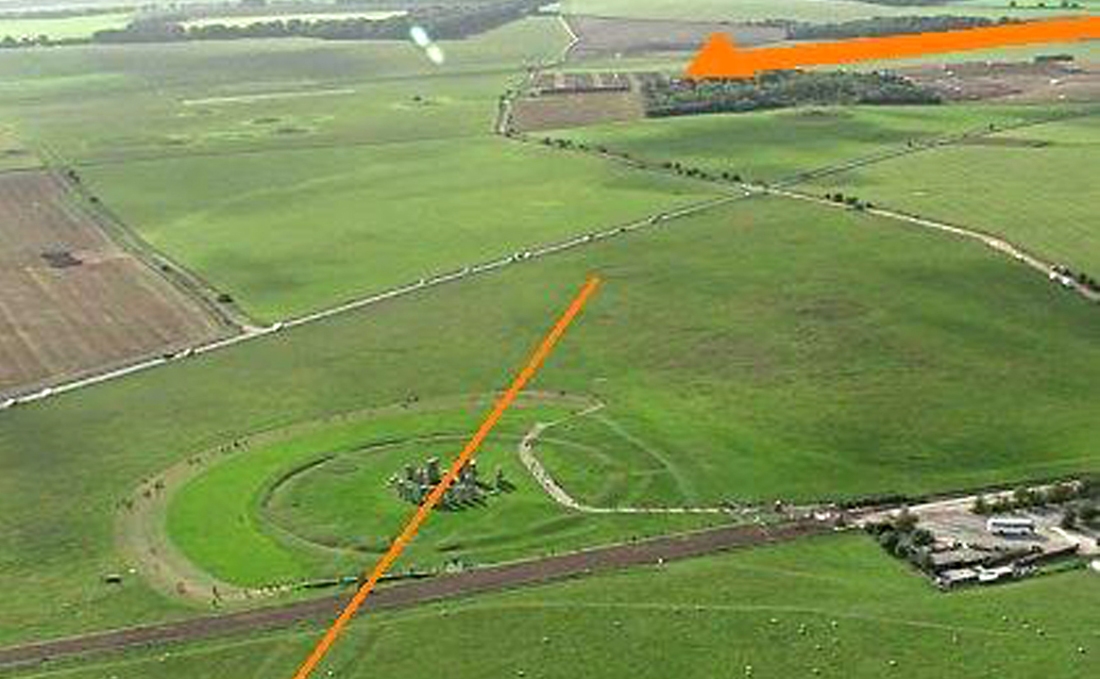
Heritage Action put it like this: “Hard to believe, but true. Even though Historic England, English Heritage and the National Trust say they are committed to ensure that ‘only schemes which protect and enhance the World Heritage Site are progressed’ it has just been revealed that Wessex Archaeology are secretly test digging at the very spot where the entrance to one version of the route would be and it’s at the very place where it would do maximum damage to the significance of Stonehenge.’ They could have said that as HE, EH and the NT want to protect and enhance the world heritage site, it’s unlikely they would’ve wanted the tunnel portal there. But where’s the fun in that?
The BBC turned it into this headline: “Stonehenge solstice sunset view ‘will be ruined by tunnel’.”
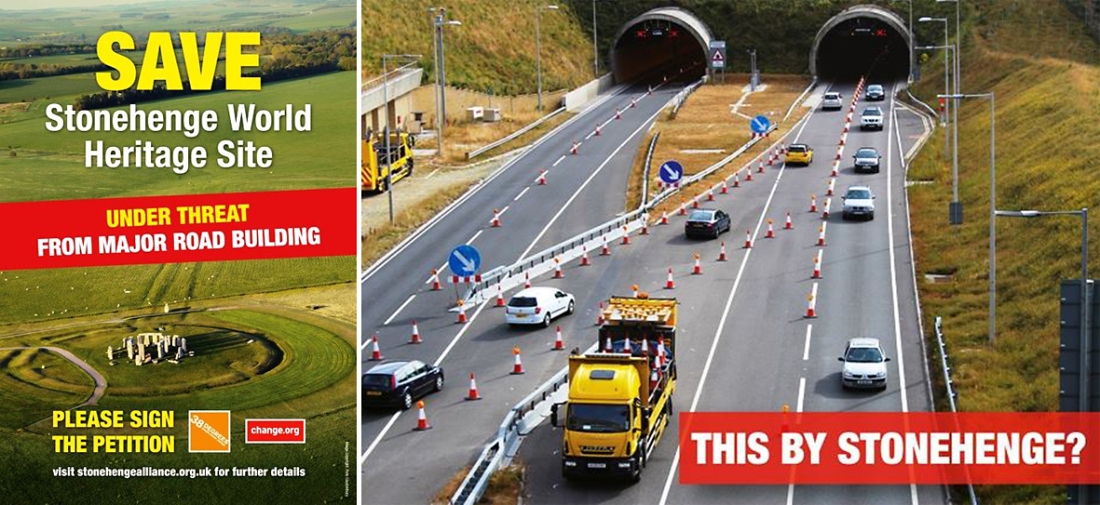
Stonehenge Alliance went ballistic on Twitter and Facebook, looking like the archaeological wing of Donald Trump’s social media campaign. They even got Tom Holland in a photo holding up their new leaflet (above), which features misleading imagery worthy of Putin-supporting trolls. Please, Tom, tell me this was a set-up job?
There can’t be many who don’t know a road tunnel may be built at Stonehenge (past, not under). But, notwithstanding all the fuss, no one knows anything about it. That’s because a decision to build a tunnel has not been taken. Its route is not known. Where the entrances might be has not been decided. Nor has how many lanes of road there would be, which brand of wine will be cracked at the opening or if anyone will be allowed to set up strawberry stalls inside it. Remember all this whenever you hear someone complain about what the tunnel will do. They’re making it up.
The place to go for what we do know is Highways England. This huge organisation is not brilliant at communication. An expected press announcement seems to be stalling from one week to the next. But it’s the best we have, so worth listening to.
There’s no question that Highways wants to upgrade the A303 as it passes Stonehenge. Its vision is “to make the A303 a free-flowing expressway, allowing mile-a-minute journeys.” Stonehenge, Amesbury and Berwick Down is one of nine schemes to effect this, with an estimated cost of £864–£1,321m – the huge range there (nearly half a billion pounds) is a hint as to how much is still undecided. The project timeline for Stonehenge begins in 1989, and ends, “to be confirmed 2020: Start on site”.
There’s not much more to say, but what there is is significant. From the timeline:
2015–2016 Route identification
TBC Early 2017 Have your say: public consultation on all route options
TBC Summer 2017 Announce our preferred/recommended option
TBC 2018 Submit planning application
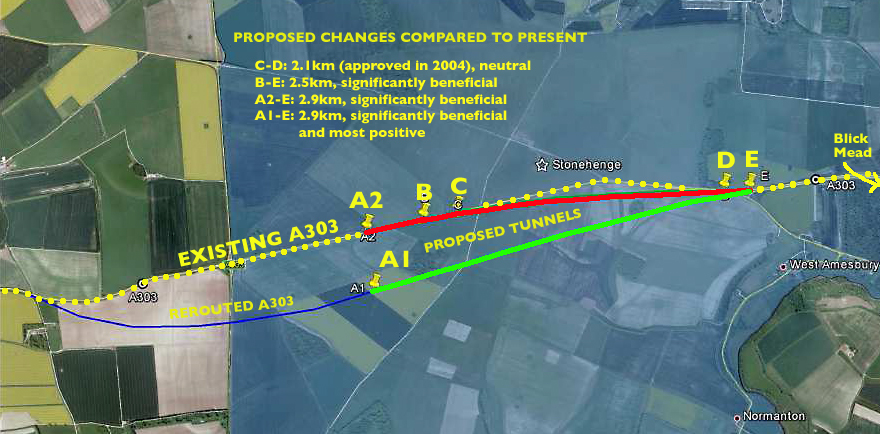
So all this stuff about portals and midwinter sunsets is premature. Currently routes are being identified – not decided on (the picture above showing proposed routes is from my earlier blog on the topic). There will be a public consultation next year. The decided route then has to get planning consent, when there will be more opportunity for scrutiny. If I was an objector, I’d wait until next year. At least I’d know what it was I was objecting to, always a help in these things.
Why were archaeologists digging in a field south of Stonehenge?
Highways needs its plans to be approved by Icomos (a conservation outfit that advises Unesco). Put another way, Icomos probably also cares about where a tunnel portal might be, and my guess is it will probably ask Highways. It’s tough in road planning, but I don’t think Highways would be able to secretly put a tunnel portal just where the sun sets at midwinter. The eagle-eyed people at Icomos would notice.
To put its case to Icomos, Highways needs evidence, which includes descriptions of what survives of archaeological interest below the soil. To get this, Wessex Archaeology was contracted to conduct yet another evaluation. In this particular case thirty trenches were dug over a wide area south of the A303. If each trench was a sign of where a tunnel would end, we’d have a portal that reached half way across the world heritage site. And note that “evaluation” is not the same as “excavation”: the idea is to dig down until you come to undisturbed remains, and then stop. Done well, little if any archaeology is touched.
So if we don’t know if or where a tunnel will happen, how can it be said that it threatens “our chance of piecing together the jigsaw to explain why Stonehenge was built”? This is what David Jacques said when he was quoted in the Guardian. His concern is with the portal at the other end, to the east, where he thinks it will damage the site of his excavations at Blick Mead. All evidence to date suggests that a tunnel wouldn’t be anywhere near the site (see map above), so why the fuss?
David’s colleague Andy Rhind-Tutt, chairman of Amesbury Museum and Heritage Trust, says “Blick Mead is without doubt one of the greatest national discoveries ever made in the Stonehenge landscape.” The latest addition to the list of discoveries is a tooth. It got a lot of attention in the media, but that simple fact is almost the only thing about the story that I’m happy not to question.
Blick Mead is important, and has considerable potential, as I explained in a feature I wrote for British Archaeology last year. To date, however, we have not had a single peer-reviewed publication about the dig or anything from it, despite the fact they began excavating there a decade ago. That’s not great for an excavation, especially in a world heritage site – but it happens. What’s not acceptable, I think, is to fail to offer your work for scientific scrutiny if you make exceptional claims for it, and regularly take them to the public, who are undoubtedly interested.
Francis Pryor writes about Blick Mead in his new book (see below). He says the artefacts are in situ; that the site has produced the largest collection of wild cattle bones yet found on a British mesolithic site; that the mud turned the flints bright pink; that it features the longest proven occupation of a British mesolithic site; that dates prove it was occupied at the same time as large posts were erected near the future site of Stonehenge. But no evidence has yet been offered to prove any of those claims.
Francis’ book was too late for the tooth. This, we are told, is evidence for “a 250-mile trip from York to Wiltshire made 7,000 years ago by a Mesolithic hunter-gatherer and his dog” (Guardian) – “evidence of the earliest journey in British history” (BBC). A leader in the Times announced, “A Mesolithic Alsatian from Yorkshire is now Stonehenge’s earliest recorded visitor.” Yet the only solid evidence we were given for this is a photo. Yup, it’s a tooth.
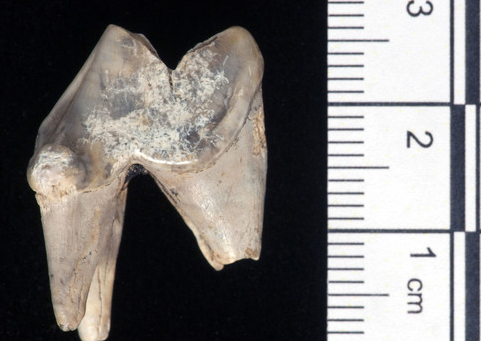
The argument is that the tooth is a domestic dog’s; that stable isotope analysis shows the dog grew up in the Vale of York; as the tooth was found in Wiltshire, the dog must have walked there from Yorkshire; the tooth was found in a mesolithic context at Blick Mead, so the journey occurred 7,000 years ago; and that is the oldest demonstrated journey in British history.
Is the tooth from a wolf or a dog, and if the latter, what did it look like? Did a dog walk to Wiltshire, or did a person carry a tooth – perhaps in a necklace? Published mesolithic radiocarbon dates from Blick Mead range from 9,500 years ago to 6,250 (note at the nearest this is over a thousand years before Stonehenge began, so pace the Times leader writer, no mesolithic dog visited it). So, given the apparent lack of stratigraphy at the site which means items can be dated only by typology or direct carbon dating, has the tooth been dated, and if not why 7,000 years ago? And the key question: do the isotope data show the beast grew up in Yorkshire?
First I asked David Jacques, as site director, for information. He declined.
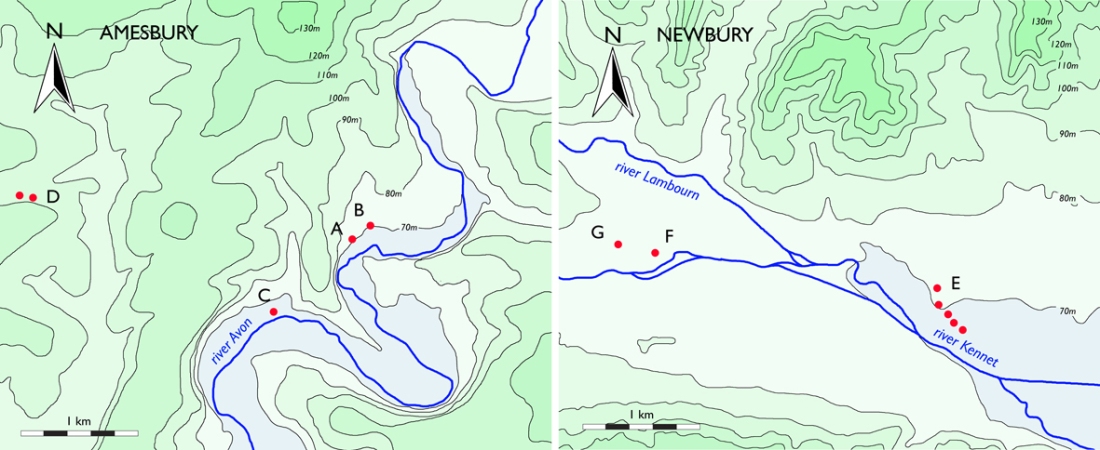
Then I asked Bryony Rogers, a research student at Durham University supervised by Janet Montgomery, who worked on the isotope analysis. She was very helpful, and what she told me was more or less what the media had reported, but with a little more detail and no hype. I learnt the tooth was a lone find. So it was not attached to a jaw or skeleton to prove a whole dog, as opposed to a tooth which might have been carried.
Bryony’s main focus was on reconstructing diet, she told me. Her data show the dog was not eating marine food, and was most likely consuming aurochs (wild cattle) and other large herbivores with the possible inclusion of freshwater fish. The dog’s diet “remained relatively constant across the time period represented by the tooth”. This is the first time that this technique has been carried out on a dog and on a sample of this age, she says. Pioneering stuff.
They also looked at the tooth enamel: this is where various stable isotopes might throw light on the creature’s migratory history. Oxygen, says Bryony, is not consistent with the dog drinking water local to Blick Mead when it was a puppy. “We suggested that the dog came from the north-east of the site,” she said, “but did not specify York as an origin. We are currently carrying out strontium isotope analysis to try and get a better understanding of the dog’s origin, as these oxygen results could also suggest an origin of higher altitude.”
The phrase “north-east of the site” rang a bell. This was exactly how Paul Budd, Jane Evans and Carolyn Chenery described the home of the beheaded Anglo-Saxon man buried at Stonehenge. They interpreted oxygen and strontium data to suggest he had grown up in an area “primarily to the north and east of the monument” (see “An Anglo-Saxon decapitation and burial at Stonehenge,” Wiltshire Archaeological & Natural History Magazine 95 (2002), 131–46, and my book Hengeworld).
The Anglo-Saxon man’s potential home territory was quite limited, and did not reach further north than Cambridge. Is it possible, I asked Bryony Rogers, that the Blick Mead dog grew up in the same area?
She said it was.
“It could be a possibility for the dog to have moved from a similar locality,” she wrote in an email. Now strontium isotopes may show the dog came from much further north. But until the analyses are done, and we have that evidence, all we can say is that the dog was not local. “We can’t say how far it travelled to the site on this evidence alone,” concludes Bryony.
Suppose it did come from Yorkshire. Would we then have the oldest demonstrated journey in British history? The key word is “demonstrated”. Hunter-gatherers can cover very wide distances over the course of a year. But do we have any evidence for this from the British mesolithic? How about the final palaeolithic, older still?
In 2012 Paul Pettitt, Marcy Rockman and Simon Chenery published a peer-reviewed article in which they claim to chemically characterise surface flint outcrops in various parts of England (Quaternary International 272/273, 275–287). Applying the analyses to artefacts made in the Creswellian era, 12–13,000 years ago, they found “some flints [had been] transported over distances ranging from the local to >200km”. More than 200km sounds like a journey to me. The mesolithic hadn’t even begun then.
The good news, is that we have been promised a peer-reviewed book on Blick Mead, edited by David Jacques and called Blick Mead: Spring Excavations. It will contain an article by Bryony Rogers, K Gron, J Montgomery, DR Gröcke & P Rowley-Conwy, “Aurochs hunters: the animal bones from Blick Mead”. Peter Lang expect to publish it early next year.

Meanwhile, we’ve had some more gentle news from Stonehenge. In late September, locals in Wylye were able to watch the latest Stonehenge replica being built. Shoots for the forthcoming Transformers: The Last Knight, gave Arthur Pendragon an opportunity to complain that setting off explosive effects in front of some polystyrene megaliths ten miles down the road from Stonehenge (and out of sight) offended the ancestors. It’s a good thing the ancestors don’t keep up with politics, or they’d be really miffed. The movie’s set to be released in June next year, to add a bit of needed colour to the summer solstice events.
Speaking of colour, over at the Society of Antiquaries’ newsletter (Salon, which I edit along with British Archaeology), a Fellow wrote in about Victorian flower shows at Stonehenge. He was reading Richard Davenport-Hines’ biography, Universal Man: The Seven Lives of John Maynard Keynes, and was surprised to learn that the great economist’s grandfather had put on displays of dahlias at Stonehenge in the 1840s. Apparently Sir Edmund Antrobus, who owned the stones, was president elect of the Salisbury Plain Dahlia Society when John Keynes snr was honorary secretary. They conspired to move the annual flower show from Everleigh to Stonehenge. As you’d expect, attendance rocketed. John “dahlia” Keynes had to issue a notice commanding that “no vehicles, booths, or standing pitches” should be put within 50 yards of the stones.
Back in 2016, “Hundreds of druids and pagans” at the site for the September equinox sounded like a very low-key affair – and quite posh, judging by the Mail Online’s photos. English Heritage now opens the stones up for full public access for the equinoxes as well as the solstices. While the solstice case is quite compelling, there is no evidence that people in 2500BC were any more aware of an equinox than they were of Christmas or April Fool’s Day. But why not?
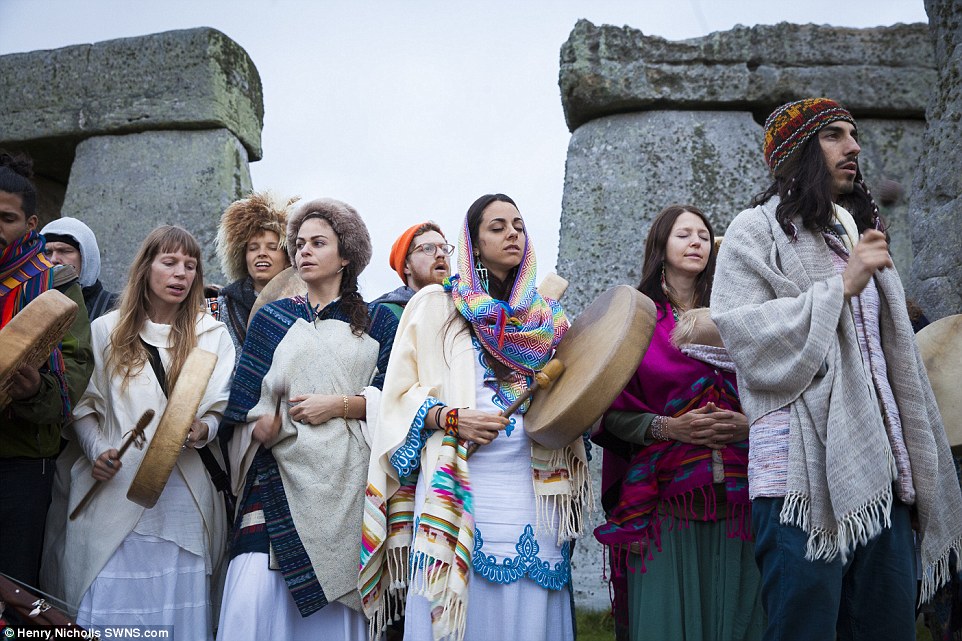
And a couple of books are out to add to the Stonehenge canon. Jane Brayne’s long-awaited – by those of us in the know – comic book inspired by the Amesbury Archer is finally done and self-published. It’s a lovely thing which I highly recommend: my daughter and I enjoyed a long Sunday breakfast in bed reading it together. Jane tells me you can find it in the shop at Stonehenge; I interviewed her for the new British Archaeology. The other title is Francis Pryor’s Stonehenge: The Story of a Sacred Landscape, nicely made by Head of Zeus, in a smallish gift format with tinted paper and much full-page art and photography. The text is a useful introduction to where we are now, in an ever-changing story (see above) of competing ideas and new evidence.
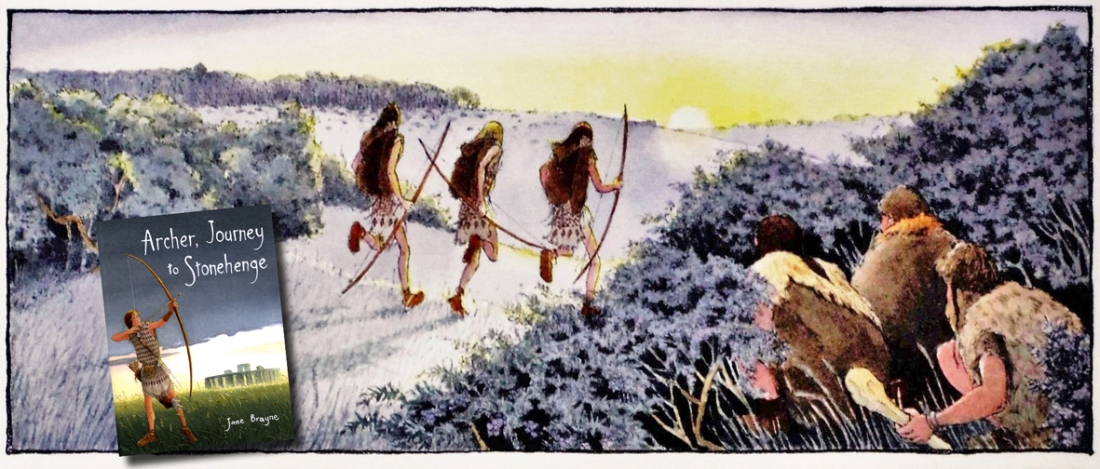
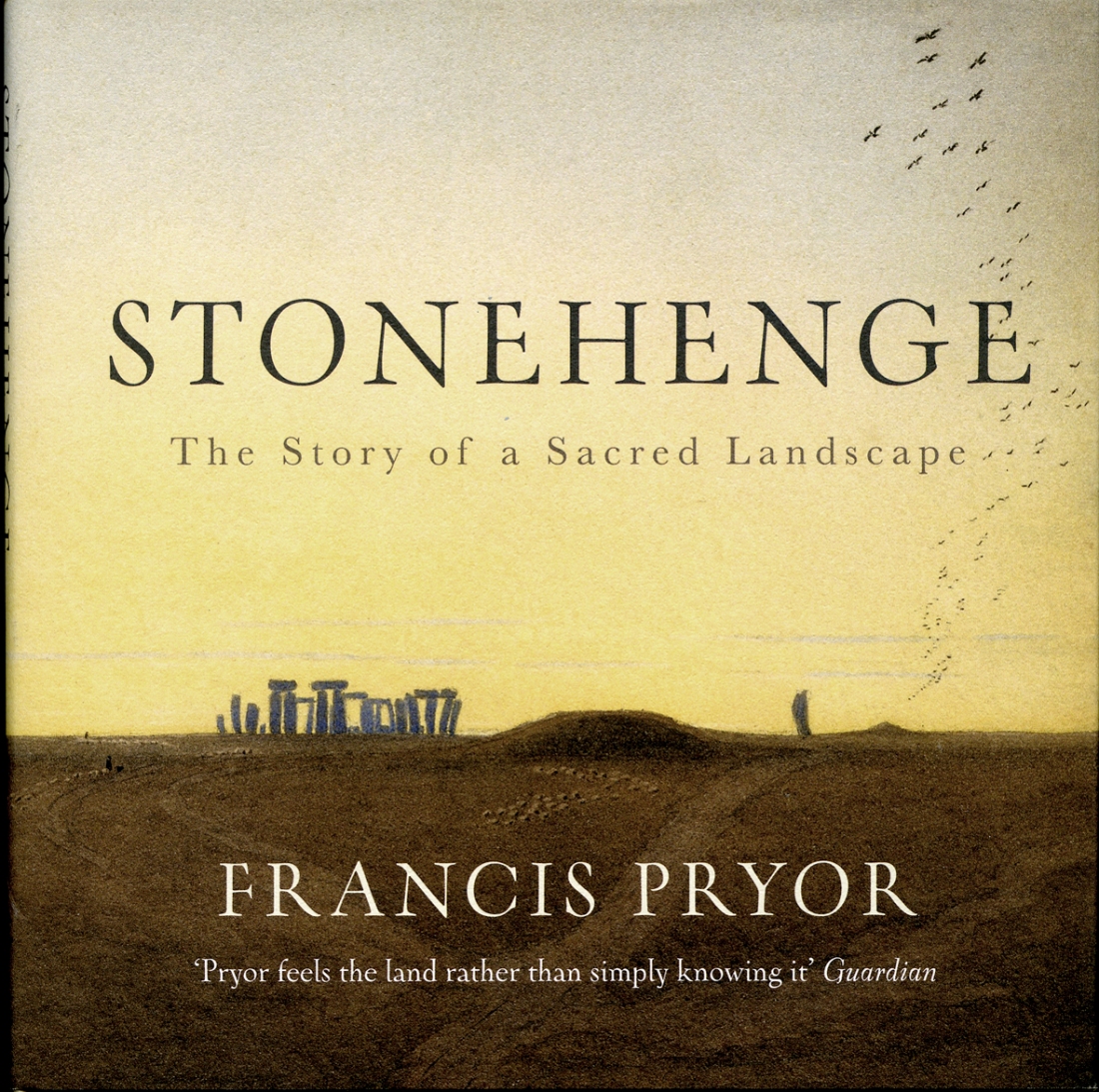
Below: map added October 20 in response to Tim Daw’s comment.
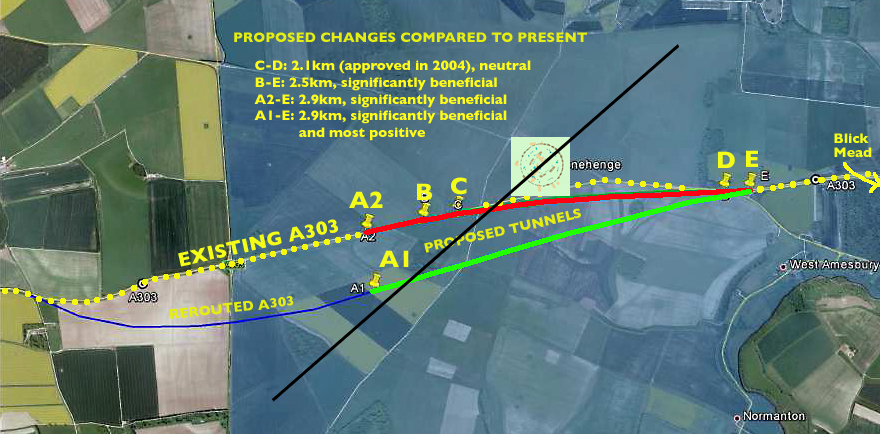
A very fair summary of the state of play, I put my hand up to touch of journalistic overstatement though I try to keep it reigned in. The point about the winter solstice sunset sightline was actually from Andy Rhind-Tutt but I fully stand behind it. I fully appreciate why the ground is being examined and how far off a plan we are but if London can have thirteen vistas protected by the London View Management Framework then I think that maybe Stonehenge deserves two at least. And before an investigating spade was put in the ground I think someone should have said this view is too important to be spoilt, let’s not waste our resources investigating here,
As I said on the blog, I would expect that Highways England would want to control traffic speeds in and around the tunnel area using a speed monitoring system like ANPR. This is the generally acknowledged gold standard of speed enforcement and generally has a calming effect on traffic; I’d expect a hard limit of 50 in the tunnels, and 60 elsewhere to be enforced but on the evening of the Solstice, a much lower limit could be enforced to compensate for necessary dimming of the LED road lighting.
I would also expect that Highways England would (or could relatively easily be persuaded to) put the A303 in a canyon for some of its length, thus hiding it from the view of observers at Stonehenge, and also greatly reducing the amount of traffic noise; the necessary LED lighting would also be below the sightline of Stonehenge observers and thus mostly invisible (LED units being much more directional than low pressure sodium lights).
Hi Tim, You might like to see our corrections regarding comments made about Stonehenge Alliance posted here https://www.facebook.com/stonehengealliance/posts/1844100009158030. Have you also spotted this excellent BBC Wiltshire interview with Simon Blanton? Posted here https://www.facebook.com/stonehengealliance/posts/1844082272493137
Even though I am only an independent researcher and not a professional Mike, I found the claims made about the dogs tooth somewhat embarrassing when actually coming from a professional archaeologist. There were so many holes in it that I assumed it was just journalistic fantasy we often see when each and every ‘first’ is claimed for anything within a five mile range of Stonehenge!
Excellent piece of writing. Thank you.
There’s a key point to remember here with this supposed tunnel portal. Apart from there being no evidence that it would be built there, and it not appearing there in any of the current published proposed routes, the location would appear to wreak havoc with the world heritage site OUV. That’s “outstanding universal value”, a concept that is taken very seriously in assessing any changes in the landscape. How would a tunnel portal so close to the stones affect OUV, bearing in mind floodlights at night (if such things were visible, they’d be a problem all year round, not just on midwinter day)? I’d say very badly.
Mike – but on your helpful diagram of possible tunnel routes above A1 is exactly where the explorations are happening and is in line with the Solstice sunset. So I don’t think it too early to raise a warning flag about that site. The only acceptable use of A1 as the start of a bored tunnel would be if the approach to it was a cut and cover cutting so that the light was contained.
That A1 point is not on the solstice sunset line, and the local topography hides it from Stonehenge, which is why it scored highly on its OUV impact (see map I’ve added at the end of the blog). Yes, it’s not a million miles away, but the important point is that test trenching in that area was part of a wider examination, and none of the sites has any direct bearing on an undecided portal location.
OK, here’s a point about light pollution.
Right now there are no streetlights at all directly visible from Stonehenge in the arc from east through south to west. There are a couple that peek through from Larkhill to the north. Precise numbers depend on time of year/tree foliage etc.
The light pollution domes that extend into the sky over the WHS at present are from Durrington/Amesbury/Solstice Park (beyond King Barrow Ridge – intense, localised and nearby), Salisbury (beyond Rox Hill – intense, widespread but distant), Rolleston Camp (beyond and north of Fargo Wood, mostly when military training is active) and Larkhill itself. The headlights from the traffic along the A303 (a) are transient and (b) tend to be “dipped”.
Any tunnel approach road coming from the A360 from the southwest will most likely need to have street lights for safety reasons. Certainly the new junction will be lit. This may be with sodium vapour or more probably with full cut-off white light LED or equivalent. Regardless of which, it will be a new source of light pollution within the WHS and will begin only half a mile away from the monument. The tunnel portal splay area will also need lighting.
It doesn’t matter if the approach is in a cutting or if the portal splay is below the horizon level from Stonehenge and behind Normanton Gorse – it’s the reflected light dome that you get even with full cut-off shrouded lights. It bounces back up from the tarmac, from vehicle roofs and windshields and the white lines on the road itself.
Leave aside, for the moment, the direct visibility of the approach road, junction and tunnel lights from King Barrow Ridge looking west-southwest or from Normanton Down and Lake Barrow Groups – all within the WHS of course.
I’ve put together a pair of simulated images alongside a reference photo of mine taken at night from by the Heel Stone looking southwest along the axis, also two other images showing the effects of the nearest sources of light pollution as seen from the monument itself (Larkhill streetlight and Rollestone/SPTA activity). The simulations show the potential light dome from the portal plus approach road and junction. Rough and ready, but serves as an illustration.
If people believe that adding new sources of light pollution into the WHS is a price worth paying then fine – you’re all entitled to that view. I respectfully disagree.
The images are here: http://web.org.uk/tmp/henge/lightdome/index.html
Glad I’ve discovered your site. I wasn’t fully aware of any ‘post-truth’ reporting in the field of Archaeology!
Thanks for taking the time to address some of these issues, Mike. May calmer heads ever prevail.
Of course, no one ‘in-the-know’ seriously expected there to be actual stones buried under the bank at Durrington, but — whew! — what a firestorm! I was somewhat disheartened by the lack of corollary coverage at the time of the August dig. In my view, what was found is much more interesting anyway!
Everything’s such a ‘Secret’ at Blick Mead I’m surprise any information is released at all! (Though I think we all know the reasons for this steady drip of tidbits). The dog tooth and its purported hard provenance had me a bit baffled at first, in that the news release came so soon after the discovery. Now it seems that, while York is still in the correct direction, “Northeast” covers a lot of ground. The bit about it perhaps being part of a necklace is also food for thought.
Last, but not least: The Tunnel. I’ve long ceased throwing up my hands at every crazy claim that’s made concerning it. Tim is definitely not one of those; his word is good, his knowledge superior, and he was asked to vacate the drove while WA dug the spot-trenches. So I paid a bit more attention to the offspring reports. In brief, it seems to me that no one’s going to allow radical interference with any event that’s associated with Stonehenge. Even the Larkhill base co-operated when the Summer Sunline was under threat. In this case I believe that there’s going to be a terrific number of people involved deciding where the portal will be sited, and many of those are well-schooled in the WHS.
We can find plenty of other reasons to oppose it.
Thanks again for the sober view,
Neil
PS: How do I reach you by email?
You can reach me through the Council for British Archaeology website here http://new.archaeologyuk.org/contact-us/ or direct at editor@britarch.ac.uk
Tony Benn’s father once advised “never wrestle with a chimney sweep”. What he meant was: if somebody plays dirty with you, don’t play dirty with them or you’ll get dirty too.
As a matter of record it is best to read oneself about the project rather than rely on this blog for information on Blick Mead.
Our work at Blick Mead 2005-2010 covered just 14 days of digging at the site (14 days in 5 years) due to landowner constraints. The work was reported in the Prehistoric Society’s PAST newsletter in November 2010. Please read – http://www.prehistoricsociety.org/publications/publication/past_66_november_2010/ (there is an error about using the term ‘thermal spring’ in this piece which was picked up by a peer reviewer).
By October 2013 we had had 32 excavation days in total. Our reporting on the work was prompt and chosen to be published in the Wiltshire Archaeological & Natural History Magazine (107) in 2014. Mike Pitts himself co-authored an article in the previous volume of this respected journal which at the time was edited by Professor Andrew Reynolds and Dr Stuart Brookes (UCL). Our article included contributions from eminent specialists such as the late Professor Tony Legge (large fauna, Cambridge University), Dr Barry Bishop (lithics, Lithics Society) and Simon Parfitt (small fauna, Natural History Museum). Please read –
Click to access Blick-Mead.pdf
This article has since been cited by leading academics in the field. For example, Professor Richard Bradley, et al see – https://www.cambridge.org/core/journals/antiquaries-journal/article/where-water-wells-up-from-the-earth-excavations-at-the-findspot-of-the-late-bronze-age-hoard-from-broadward-shropshire/D2AF3769DE100BE6D198C9CA5DD88FF1
Professor Tim Darvill, et al see – http://www.tandfonline.com/doi/abs/10.1080/1751696X.2016.1171496
Its results are also amply and supportively discussed by Professor Mike Parker Pearson, et al in http://eprints.soton.ac.uk/383912/
Mike’s review that – “Despite 50 years of large scale excavations across western Europe, the Stonehenge posts are unrivalled as Mesolithic monuments. They date to the earliest stages of Blick Mead so it is likely that people gathering there were responsible for erecting them” (p.2). And -“The camp at Blick Mead may have been far more than just a handy place to gather, but somewhere that people returned to as a place of origin. Over the centuries and millennia it was used, this place would have become the centre of a network of paths leading towards it from many parts of southern Britain. Just as all roads led to Rome, so all these paths led to the future site of Stonehenge”(p. 43) – underscores the efficacy of our results and interpretations.
Since 2014 we have been in the process of compiling a monograph on the work at the Blick Mead spring. Specialist contributions include the already peer reviewed Durham University analysis of the large fauna, Dr Sophy Charlton (Natural History Museum, formally York University) ZoomS analysis, Simon Parfitt’s analysis of the small fauna, Reading University’s QUEST environmental report, Dr Barry Bishop’s lithics analysis, The Stonehenge Hidden Landscape Project’s GPR survey, Professor David John’s (Natural History Museum) analysis of algae (magenta pink phenomena) and a full field report –
Blick Mead: Spring Excavations, D. Jacques. (ed.). Oxford. (I sent this link to you Mike in response to your request two weeks ago (?)).
A couple of other things need clearing up.
In his piece Mike silkily describes Andy Rhind-Tutt as a “colleague”. Andy is a well respected member of the local community of Amesbury, the chosen representative of one of the landowners, in charge of site security therein and a passionate and valued friend and supporter of our work, but he would be the first to tell you that he has no professional archaeological relationship to the project. Colleagues of ours in those terms are as above and also include Professor Tony Brown (environmental specialist, Southampton University) and Professor Peter Rowley-Conwy and Bryony Rogers (fauna, Durham University).
The press reporting of the dog’s tooth story took all of the ambiguity out of the press releases provided by University of Buckingham and Durham University. Please see – http://www.buckingham.ac.uk/latest-news/earliest-journey-in-british-history-unearthed/ for both university responses.
The Times did however publish my letter about the value of A’ level Archaeology, teaching Archaeology in schools in general and its benefits for local communities, as exemplified by the Blick Mead project, yesterday , so that was positive- http://www.thetimes.co.uk/article/culture-creativity-and-the-axing-of-a-levels-nkdr0s7sv
In short the Blick Mead Project has generated an immense amount of goodwill from the local community and the wider archaeological community. Specialists and locals on the ground appreciate how hard it has been to dig on what is very private land and the subsequent problems with various logisitics and funding that entails. We are delighted that Amesbury Town Council has found funding to build a new museum next year to house the town’s archaeology on the back of our discoveries. During this years dig a pleasingly high and diverse group of local people participated in the work and we were visited as usual by Historic England’s Dr Phil McMahon and Dr Mark Bowden and the National Trust’s Dr Nick Snashall. Other specialist visitors were Professor Martin Bell, Professor Tony Brown, Professor Tim Darvill, Professor David John, Dr Barry Bishop and Julian Richards. In previous times Wiltshire County Archaeologist’s have attended, as have Dr Chantal Conneller, Roy Froome, Dr Jonathan Last, Professor Richard Bradley, Professor Nick Branch, Professor Caroline Wickham-Jones, Professor Peter Rowley-Conwy and Professor Mike Parker-Pearson The team has benefited from all the various feedback and work and our analysis of site dynamics has been informed it. We hope the readers of this blog will be too.
David Jacques, Blick Mead Project
Your blog has criticised the Stonehenge Alliance’s new leaflet for misleading imagery and information. We would like to correct a number of errors in your blog relating both to our leaflet and to the A303 widening project.
Our leaflet clearly states that it is the World Heritage Site that is under threat, not the henge. It bears an image of twin tunnel portals at Hindhead and asks whether such portals might be built by (i.e. not under) the henge. The image on our leaflet is labelled ‘Hindhead image courtesy Wikipedia’. Your blog selected an image without the label inadvertently published on our Facebook and since superseded.
The Alliance’s leaflet graphically compares the width of the WHS with a tunnel length of 1.8 miles and, although we don’t know where the portals might lie, both pairs would sit within the WHS as indicated on the maps used by your blog. Contrary to your assertion, a decision about the tunnel has been taken and has not yet been withdrawn. A 1.8 mile (2.9km) tunnel was announced in Parliament in December 2014, along with the funding for it.
Highways England has told us recently that the 1.8 mile tunnel is their ‘working assumption’. This naturally raises serious questions about the credibility of the consultation process. The cost range for the Amesbury to Berwick Down improvement relates to standard production of low to high estimates for the work, not, as you suggest, to subsequent costing decisions.
We may reasonably guess that evaluation trenching on the line of the winter solstice may have been prompted by the need to fit a 1.8 mile tunnel into the topography of the landscape and to locate an eastern portal east of the ancient Avenue as advised by UNESCO’s mission.
We’d like to take this opportunity to underline the fact that the 1.8 mile tunnel was not endorsed by UNESCO as asserted in the media. UNESCO’s World Heritage Committee’s Advisory Mission, whose object was to give advice only, made this clear in its report (page 9).
The Advisory Mission’s report also reminds HMG of its commitment under the World Heritage Convention. That obligation, under Article 4, is to protect the whole World Heritage property – a commitment that would obviously not be met by a road scheme that would further damage the WHS.
On such a complicated and important issue now before us, we do think it right to express opinions based on facts where these are known. We would be glad to share information, should Mike wish to consult with us.
These corrections and images referred to can be found here https://www.facebook.com/stonehengealliance/posts/1844100009158030
After such a phenomenal discovery as the Blick Mead site itself and the stupendous subsequent findings there, and having also hopefully now overcome the time constraints on working Blick Mead (i.e. 14 days in 5 years), please Mike, David et al do not let what has already turned into a soap opera descend into farce! It is time for constructive discussion rather than mud-slinging (to continue the getting down and dirty metaphor)!
Hi Roger. Not sure that this is even. Mike continually puts out inaccurate comments about the project. David Jacques and team have tried to keep above it despite a lot of provocation seems to me. His ‘right to reply’ to Mike’s demeaning BA article on Blick Mead last year has even been taken down from the web by Mike! Where’s the fairness in that? Especially with him going on and on with half truths about Blick Mead. Surely Mike must have read the articles and got wind of the fact that it is not just media celebs like Francis Pryor who are writing about Blick Mead? I think he is assuming that rest of us aren’t reading what is coming out of the site and that we are less informed than we are. I for one am very disappointed to be treated like that. I’m not a mug.
This is not what we should expect from the editor of a national mag and a CBA publication to boot (which I read). First time I have felt I needed to blog ever. Sort yourself out Mike pitts, these sort of projects which really involve locals and don’t have much money are the ones to support and offer help too, not bully.
Hi Abigail. You’ll have to remind me, I’m afraid. What have I taken down from the web? What inaccurate comment or half truth are you referring to? Where in my British Archaeology feature (in which I describe the Blick Mead site as important, and highlight the contributions of local people) is there anything demeaning? Your comment makes no sense to me, but I’m happy to help if you explain.
I can’t help noticing that Mike Pitts has replied very swiftly to Abigail but, so far, has nothing to say to David Jacques detailed rebuttal of his blog
That’s because there is nothing in David’s comment that contradicts anything I have written, nor do I take issue with anything he says (we’re all entitled to our opinions). I did, however, write an entirely new blog (about the tooth) having followed up one of his links.
Whether individual stories were totally accurately portrayed in the article isn’t that relevant. Mike’s article seems to me to reflect how everyone else sees the constant flow of inaccurate stories about archaeology. It’s not flattering and it doesn’t add to the credibility of the field as a whole.
I have to agree with you totally Jonathan – especially when it comes to Stonehenge and its environs. It’s a shame that more sites and areas aren’t given the attention that this continually being re-invented cash-cow is allowed.
The number of points raised in the original piece posted this month, and the subsequent discussions on Blick Mead on the blog, wouldn’t have been
necessary had the points raised by David Jacques in his online reply to the article in the May/June 2015 edition of British Archaeology been taken into consideration. Below is the full text from a print out of his online reply I took at the time. Like Abigail, I can no longer find this on the BA website. Where is it? Why was it taken down? Does anyone know?
Update from Blick Mead Project Director
The Blick Mead team are very grateful to the CBA for letting us reply to the article in the May/June edition of British Archaeology about our research into Mesolithic Blick Mead.
We would like to draw attention to references which do not clearly reflect the amount of research and depth of analysis undertaken at Blick Mead. For example, there is no reference in the article to:
* University of Reading’s environmental science team’s work on the site and the data collected since 2013 (‘Current Archaeology’, 293).
* The detailed research into the extent of the 18th century landscaping of Vespasian’s Camp, which was crucial for locating the north east area of the camp as a target area prior to excavation – http://www.buckingham.ac.uk/research/hri/fellows/jacques/18thcentury.
* The GPR survey work the University of Birmingham’s Hidden Landscapes Project team has undertaken since 2013 (BBC 2 ‘Operation Stonehenge’, September 2013. Vince Gaffney’s and Eamonn Baldwin’s email addresses were provided to ‘British Archaeology’ November 4th 2014 and subsequently).
* Durham University’s analysis of the large faunal assemblage, including isotope analyses, started in 2014 (Peter Rowley-Conwy’s email address was provided to ‘British Archaeology’ November 4th 2014 and subsequently).
In addition, there are misrepresentations within the article. In particular:
* The radiocarbon date range significance – 7596-4695 BC, from 11 dates in each of those millennia from the spring, is not clearly illustrated. It represents the longest chain of Mesolithic dates from any site in Europe (two of the dates are contemporaneous with the radiocarbon dates from the pits beneath the former car park at Stonehenge, not one, as reported.
* With regard to the provenance of the flint assemblages recovered from the spring, we do not consider the material to be “dumped”, as reported (see Barry Bishop’s ‘Assessment of the lithic material pp15-16, and ‘Discussion’ pp22-24, in the 2014 WAHN article referenced – http://www.buckingham.ac.uk/wp-content/uploads/2014/12/Blick-Mead.pdf).
* The project team’s initial motivation for examining the Blick Mead area is not accurately represented.
* Project supervisors Tom Phillips and Tom Lyons did not present Barry Bishop with “bags of muddy flints” at the Oxford Archaeology East office. The project team has never taken unprocessed artefacts off the site. In fact, funding from the Wiltshire Unitary Authority helped us pay for a targeted excavation of this material in 2011 and English Heritage gave us funding which helped pay for the specialist analysis of it.
Finally, the project team are largely comfortable with the national media stories about Blick Mead. ‘The Sun’ ran two stories about the Mesolithic diet following our work. The BBC children’s programme ‘Newsround’ reported the Stonehenge landscape being visited long before the Neolithic as a result of Amesbury being acknowledged as the longest occupied place in the UK. Additionally, BBC 2’s ‘Horizon’ commissioned a programme re-assessing the Mesolithic and the ‘Neolithic revolution’ in Britain directly as a result of publicity about results from our work. This is due to be broadcast in May 2015 under the title ‘The First Britons’. This is good outreach, very much in the spirit of ‘archaeology for all’.
David Jacques, project director ‘Blick Mead Project’.
In her comment above, Abigail noted that David Jacques’ “‘right to reply’ to [my] demeaning BA article on Blick Mead last year has even been taken down from the web by Mike!” I’m going to address this now.
In all honesty, I’d forgotten about the text to which Abigail referred, and I’m sorry about that. I had little to do with it. We have a Letters page in British Archaeology, and a “Phase 2” column for updates and corrections. These are designed for magazine feedback, and that’s how people use them (you could call them an opportunity for a “right of reply”, but that sounds rather grand, they are just normal means for comment, open to all). However, David Jacques instead wrote to Mike Heyworth, director of the Council for British Archaeology – as far as I can remember the only time anyone has chosen this way of responding since I started editing the magazine in 2003. I suggested to David he might find it useful to write a letter to the magazine. He didn’t want to, so I edited a shorter text from his online submission to the CBA, shown to me by Mike Heyworth, and printed it as if he had written a letter, with a link.
I did not take the online text down (why would I? I wouldn’t even know how to). I inquired and found it had accidentally gone when the page about a new magazine had been updated. The CBA has now put it back, and you can find it here http://new.archaeologyuk.org/Blick-Mead-project-director-update.
Those of you who criticise what I have written about the Blick Mead excavation are of course welcome to do so, but I’d like to make a point. I am interested in the archaeology of the site, and that is what I write about (as it happens, I know quite a lot about the mesolithic, so I can do so as a specialist as well as an observer). I am not in the least interested in the personalities or motivations of anyone involved, and I have never said anything about such matters, nor would I. Nor have I commented on the quality of the fieldwork. To call my British Archaeology feature on Blick Mead “demeaning” and to say I “continually put out inaccurate comments about the project”, as Abigail does, is nonsense. Keith Bradbury above suggests that had I addressed “the points raised by David Jacques in his online reply to the article in … British Archaeology”, the blog discussion wouldn’t have been necessary. This is misguided.
No one has meaningfully challenged any of the factual statements or analyses I have presented about the dig. I have been relentlessly polite in my dealings with everyone, and my focus has always been on the archaeology and the science. I would love to hear back from the project director with evidence to put me right where I have questioned interpretations, and I will be delighted when we finally see some peer-reviewed publications (David Jacques may be pleased with coverage in the Sun, but frankly that is not really how scientific debate progresses). But please, do not blame me if others talk of “playing dirty”. That is not my style.
Mike, unfortunately your comments continue to misrepresent..
Saying excavators brought muddy bags of flint to be analysed by a specialist is demeaning . To choose to not represent the fact that there have been many positive peer responses on the project’s publication output is a choice to diminish the value of the project in another way. The decision to mention ‘the Sun’ reference rather than deal with the detailed peer response to the site is also unworthy of you. In sum, it is your general approach to the site so far that is misguided, not Abigail’s. If I were Jacques I wouldn’t be drawn into this anymore.
As you must know, the place of publication – peer reviewed or not – is irrelevant with regards to a university submitting to the government’s own Research Excellence Framework where items are judged purely on their own merit along with peer responses and citations. The Wilts.Archaeological journal (WAM) article, as Jacques said in his post, was read and commented on by a number of leading academics in the field. WAM has managed perfectly well for over 150 years with an editorial board consisting of leading academics who review articles before they are chosen for publication.
Incidentally, the article on Blick Mead in WAM was also deemed valuable enough to be cited by Professor Charlie French, a member of the Stonehenge Riverside Project team, in his recent book –
https://books.google.co.uk/books?id=ixUDDAAAQBAJ&pg=PA50&lpg=PA50&dq=charles+french+blick+mead&source=bl&ots=qVCuaIIRWy&sig=s9FZW1QUqDbzVAFqdUM6BfVamzs&hl=en&sa=X&ved=0ahUKEwjOg4ndpJ7QAhVnCMAKHcNZA_IQ6AEILjAD#v=onepage&q=charles%20french%20blick%20mead&f=false
Professor French’s publication wasn’t referenced in Jacques’s post, nor were the Blick Mead team’s two articles published in Current Archaeology since 2012. This means that there have been 4 publications on the site since 2010 – pretty good going by archaeological publication time standards and especially so with the time and financial constraints this project has operated under.